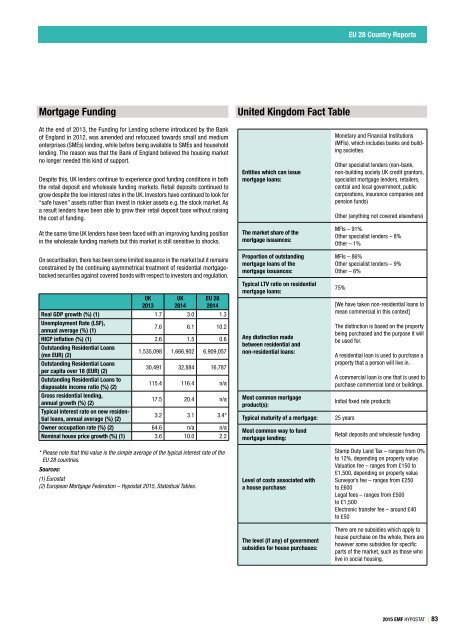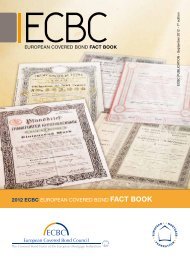Hypostat 2015
On 30 September 2015, the EMF-ECBC published Hypostat 2015 , which is its main statistical report, encompassing data on recent developments in housing and mortgage markets in the EU28 and beyond. Hypostat is the result of a collaborative effort by the European Mortgage Federation’s national delegations and external experts. The publication covers 33 countries – i.e. the EU28 plus Iceland, Norway, Russia, Turkey and the United States.
On 30 September 2015, the EMF-ECBC published Hypostat 2015 , which is its main statistical report, encompassing data on recent developments in housing and mortgage markets in the EU28 and beyond. Hypostat is the result of a collaborative effort by the European Mortgage Federation’s national delegations and external experts.
The publication covers 33 countries – i.e. the EU28 plus Iceland, Norway, Russia, Turkey and the United States.
Create successful ePaper yourself
Turn your PDF publications into a flip-book with our unique Google optimized e-Paper software.
EU 28 Country Reports<br />
Mortgage Funding<br />
United Kingdom Fact Table<br />
At the end of 2013, the Funding for Lending scheme introduced by the Bank<br />
of England in 2012, was amended and refocused towards small and medium<br />
enterprises (SMEs) lending, while before being available to SMEs and household<br />
lending. The reason was that the Bank of England believed the housing market<br />
no longer needed this kind of support.<br />
Despite this, UK lenders continue to experience good funding conditions in both<br />
the retail deposit and wholesale funding markets. Retail deposits continued to<br />
grow despite the low interest rates in the UK. Investors have continued to look for<br />
“safe haven” assets rather than invest in riskier assets e.g. the stock market. As<br />
a result lenders have been able to grow their retail deposit base without raising<br />
the cost of funding.<br />
At the same time UK lenders have been faced with an improving funding position<br />
in the wholesale funding markets but this market is still sensitive to shocks.<br />
On securitisation, there has been some limited issuance in the market but it remains<br />
constrained by the continuing asymmetrical treatment of residential mortgagebacked<br />
securities against covered bonds with respect to investors and regulation.<br />
UK<br />
2013<br />
UK<br />
2014<br />
EU 28<br />
2014<br />
Real GDP growth (%) (1) 1.7 3.0 1.3<br />
Unemployment Rate (LSF),<br />
annual average (%) (1)<br />
7.6 6.1 10.2<br />
HICP inflation (%) (1) 2.6 1.5 0.6<br />
Outstanding Residential Loans<br />
(mn EUR) (2)<br />
1,535,098 1,666,902 6,909,057<br />
Outstanding Residential Loans<br />
per capita over 18 (EUR) (2)<br />
30,491 32,884 16,787<br />
Outstanding Residential Loans to<br />
disposable income ratio (%) (2)<br />
115.4 116.4 n/a<br />
Gross residential lending,<br />
annual growth (%) (2)<br />
17.5 20.4 n/a<br />
Typical interest rate on new residential<br />
loans, annual average (%) (2)<br />
3.2 3.1 3.4*<br />
Owner occupation rate (%) (2) 64.6 n/a n/a<br />
Nominal house price growth (%) (1) 3.6 10.0 2.2<br />
* Please note that this value is the simple average of the typical interest rate of the<br />
EU 28 countries.<br />
Sources:<br />
(1) Eurostat<br />
(2) European Mortgage Federation – <strong>Hypostat</strong> <strong>2015</strong>, Statistical Tables.<br />
Entities which can issue<br />
mortgage loans:<br />
The market share of the<br />
mortgage issuances:<br />
Proportion of outstanding<br />
mortgage loans of the<br />
mortgage issuances:<br />
Typical LTV ratio on residential<br />
mortgage loans:<br />
Any distinction made<br />
between residential and<br />
non‐residential loans:<br />
Most common mortgage<br />
product(s):<br />
Typical maturity of a mortgage:<br />
Most common way to fund<br />
mortgage lending:<br />
Level of costs associated with<br />
a house purchase:<br />
The level (if any) of government<br />
subsidies for house purchases:<br />
Monetary and Financial Institutions<br />
(MFIs), which includes banks and building<br />
societies.<br />
Other specialist lenders (non-bank,<br />
non-building society UK credit grantors,<br />
specialist mortgage lenders, retailers,<br />
central and local government, public<br />
corporations, insurance companies and<br />
pension funds)<br />
Other (anything not covered elsewhere)<br />
MFIs – 91%<br />
Other specialist lenders – 8%<br />
Other – 1%<br />
MFIs – 86%<br />
Other specialist lenders – 9%<br />
Other – 6%<br />
75%<br />
[We have taken non-residential loans to<br />
mean commercial in this context]<br />
The distinction is based on the property<br />
being purchased and the purpose it will<br />
be used for.<br />
A residential loan is used to purchase a<br />
property that a person will live in.<br />
A commercial loan is one that is used to<br />
purchase commercial land or buildings.<br />
Initial fixed rate products<br />
25 years<br />
Retail deposits and wholesale funding<br />
Stamp Duty Land Tax – ranges from 0%<br />
to 12%, depending on property value<br />
Valuation fee – ranges from £150 to<br />
£1,500, depending on property value<br />
Surveyor’s fee – ranges from £250<br />
to £600<br />
Legal fees – ranges from £500<br />
to £1,500<br />
Electronic transfer fee – around £40<br />
to £50<br />
There are no subsidies which apply to<br />
house purchase on the whole, there are<br />
however some subsidies for specific<br />
parts of the market, such as those who<br />
live in social housing.<br />
<strong>2015</strong> EMF HYPOSTAT | 83



